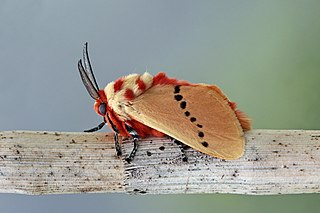
The flannel moths or crinkled flannel moths are a family of insects. They occur in North America and the New World tropics. The larvae are called puss caterpillars, and with their long hairs, resemble cotton balls. They have venomous spines that can cause a painful sting and inflammation lasting for several days. In some cases, the sting may cause headache, nausea, and shock-like symptoms. Perhaps the most notorious for stinging is the caterpillar of Megalopyge opercularis.
Podalia is a genus of moth in the family Megalopygidae.
Norape is a genus of moth in the family Megalopygidae.
Microrape is a genus of moth in the family Megalopygidae.

Trosia is a genus of moths in the family Megalopygidae described by Jacob Hübner in 1820.
Hysterocladia is a genus of moth in the family Megalopygidae.

Aithorape is a genus of moth in the family Megalopygidae.
Microrape camela is a moth of the family Megalopygidae. It was described by Walter Hopp in 1927. It is found in Colombia.
Microrape cristata is a moth of the family Megalopygidae. It was described by Walter Hopp in 1927. It is found in Brazil.
Microrape filata is a moth of the family Megalopygidae. It was described by Walter Hopp in 1927. It is found in Colombia.
Microrape gnathata is a moth of the family Megalopygidae. It was described by Walter Hopp in 1927. It is found in Peru.
Microrape hippopotama is a moth of the family Megalopygidae. It was described by Walter Hopp in 1927. It is found in Colombia.
Microrape simplex is a moth of the family Megalopygidae. It was described by Walter Hopp in 1927. It is found in Peru.
Microrape signata is a moth of the family Megalopygidae. It was described by Walter Hopp in 1930. It is found in Brazil.
Microrape santiago is a moth of the family Megalopygidae. It was described by Walter Hopp in 1922. It is found in Colombia.
Microrape jasminatus is a moth of the Megalopygidae family. It was described by Paul Dognin in 1893. It is found in Brazil, Bolivia and Ecuador.
Microrape minuta is a moth of the Megalopygidae family. It was described by Herbert Druce in 1886. It is found in Panama and Costa Rica.
Microrape shilluca is a moth of the Megalopygidae family. It was described by William Schaus in 1929. It is found in Brazil.
Norape truncata is a moth of the family Megalopygidae. It was described by Walter Hopp in 1927. It is found in Venezuela, Peru and Colombia.
Trosia ochracea is a moth of the family Megalopygidae, first described by Walter Hopp in 1922. It is found in Brazil.




